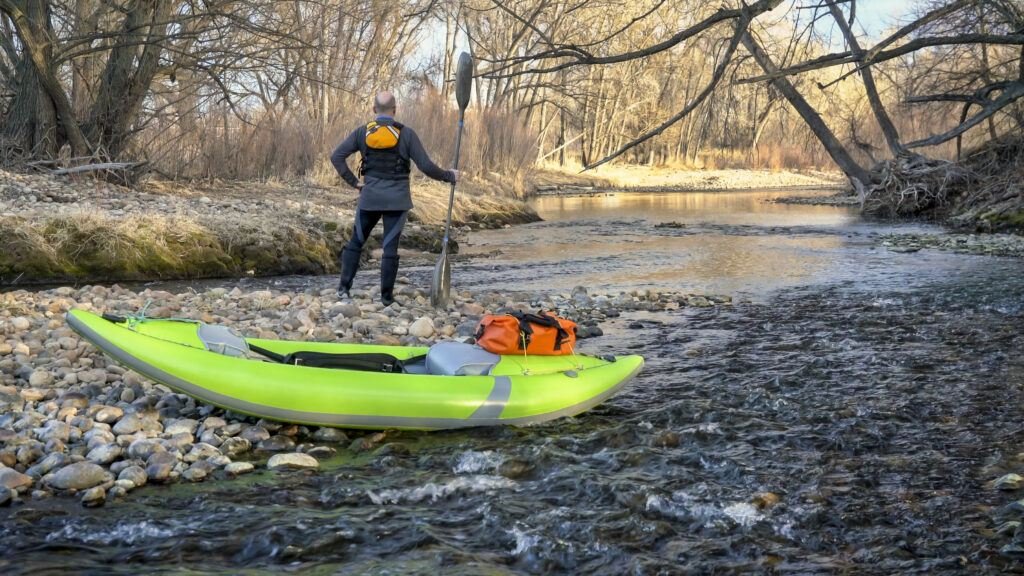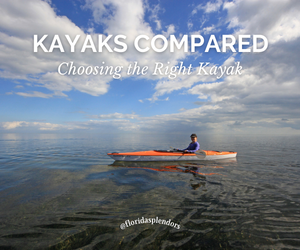Checking kayaks compared is sensible. After all, Florida’s beaches, pristine oceans, and year-round warmth attract tourists. It’s ideal for watersports enthusiasts. Also, kayaking lets you experience the state’s mangrove tunnels, freshwater springs, and calm bays. Yet boat selection is difficult, especially for beginners.
A Beginner’s Guide to Kayaks Compared
Kayaks compared are worth seeing. After all,
kayaking is a thrilling water sport for all ages and experience levels. Yet, many boats are available, making it challenging for novices to select the best one. This article compares sit-on-top, sit-inside, recreational, touring,
inflatable, hardshell, whitewater, and sea
kayaks. Understanding the distinctions helps you pick the right boat. This article will help novice, and seasoned boaters choose the
kayak for their next trip.

Get the perfect boat.
Kayaks Compared: Sit-On-Top vs. Sit-Inside Kayaks
The first significant distinction when comparing kayaks is between sit-on-top and sit-inside kayaks. Remember that unique types of kayaks cater to individual demands. Sit-on-top kayaks are stable and easy for beginners and leisure paddlers. They have an open cockpit for easy entry, departure, and swift water movement. With a cockpit to sit in, sit-inside kayaks provide better weather protection. They are faster and more maneuverable than sit-on-top kayaks. These features make them a good choice for experienced kayakers. They’re also great for long-distance travelers.
Sit-on-top kayaks and sit-inside are different types of kayaks. But people use both types for fun or sports. Here are some ways they are the same:
-
Paddling technique: The primary way to paddle both kayaks is the same. The paddler uses a double-bladed paddle to move the kayak through the water.
-
Watercraft: Sit-on-top kayaks and sit-inside kayaks are small boats. With them, the paddler moves by paddling.
-
Material: Plastic, fiberglass, and composites are some materials manufacturers use.
-
Uses: Boaters can fish, cruise, and swim in both kayaks.
-
-
Portability: Both are movable by car or by other means. People can store them in a basement, attic, or shed when unused.
Yet, sit-on-top and sit-inside kayaks differ in where you sit, ease of use, and water type.
Kayaks Compared: Recreational vs. Touring Kayaks
Sit-inside kayaks differ more between recreational and touring kayaks. Recreational kayaks are shorter and broader. They’re more agile and stable in calm environments. They’re a good choice for casual paddling, fishing, or exploring tranquil waterways. Yet, touring kayaks look very different. These attributes make them better for open ocean and long-distance trips. They are longer and narrower for speed and efficiency with sharper bow and stern. They may also have a rudder or skeg to make them easier to steer and more stable.
People make sea kayaks, which are touring kayaks, to use in the ocean. They are longer and slimmer than other touring kayaks. Also, they have pointed bows and sterns for open water. Still, they are shorter than most touring kayaks. These features make them less affected by the wind and easier to steer in rough water. Most sea kayaks have dry places to store gear, food, and other essential things for longer trips. They also have a rudder or skeg that helps the paddler steer the kayak when there are strong winds or currents.
Kayaks Compared: Inflatable vs. Hardshell Kayaks
Another comparison to consider is between inflatable and hardshell kayaks. Inflatable kayaks offer many advantages, including portability and ease of storage. They’re also generally more affordable than hardshell kayaks. Yet, they may be less effective than hardshell kayaks in stormy seas or high gusts. Kayaks with hard shells are more robust and efficient. Extreme kayakers and those who kayak in more demanding situations might consider them.
Kayaks Compared: Whitewater vs. Sea Kayaks
Moreover, knowing the distinctions between kayaks for different types of water is crucial. A whitewater kayak can handle rapids and fast-moving water. Their rounder bottom and higher rocker make them more flexible and shorter. But sea kayaks are more stable and comfortable paddling on open water for long periods. They are longer and narrower than whitewater kayaks. Also, the bottom is flatter to help them track and move faster.
What to Think About When Buying a Kayak
Compare kayak types because each class has particular purposes and conditions. Getting the right kayak can make a big difference in how you feel on the water. Here are some reasons why you should compare different types of kayaks:
- Performance: Kayak construction affects water performance. Boat speed, stability, and maneuverability depend on hull length, width, and shape. When you compare kayak types, you can find the one that works best for what you want to do with it.
- Conditions: Different types of kayaks work better in different kinds of water. A leisure boat may work better in calm lakes or ponds than a sea kayak. By comparing different types of kayaks, you can find the one best for the conditions you want to paddle in.
- Comfort: Kayak seating and other elements might affect water mobility. Some kayaks have the best seats, adjustable footrests, or cozy designs. These things can make a big difference on longer paddles. By comparing kayak types, you can find the one that fits your body type and how you want to use it best.
- Storage: Different types of kayaks have different amounts and ways to store things. Some kayaks have watertight hatches to protect goods, while others have large cockpits for easy access. You can find the one that best fits your storage needs by comparing kayak types.
Comparing kayak types is crucial to choosing the right one for your needs and conditions. Consider performance, needs, comfort, and storage while choosing a kayak.
Wrapping Up
Choosing the right kayak can make all the difference in your kayaking experience. Compare kayaks to pick the best one for you. Knowing the main distinctions between kayaks can help you choose. That would depend on whether you’ll kayak in protected waters or open seas.
We hope that this comparison of kayaks has been helpful and informative for you. To learn more about kayaking and other water sports, check out our blog for helpful tips and insights. You can enjoy kayaking to the fullest with the proper gear and knowledge.
Discover the perfect kayak paddle size for your adventures with our comprehensive
kayak paddles size chart. Find the ideal paddle length and blade size to enhance your performance on the water. Explore our kayak paddles size chart today!
FAQs
What kind of kayak is best for a beginner?
Sit-on-top kayaks are sturdy and easy for beginners. Lakes and slow-moving rivers suit these open-cockpit self-draining kayaks. A boat with a high-angle design is helpful for beginners. It can accommodate more paddlers while giving beginners buoyancy and power. A beginner can enjoy a stable kayak for bracing and rolling too. Riding something with a firm catch and smooth linking strokes would be great.
What kind of material is best for kayak paddles?
Makers construct most boat paddles with aluminum, carbon fiber, or fiberglass. Carbon fiber paddles are strong and light, while fiberglass paddles are durable. The best material for a kayak paddle depends on what you need and what you like. The Bending Branches Angler Classic is an example of a high-quality fiberglass paddle. Most paddlers will enjoy a high-angle paddle. After all, it floats, makes a lot of power, and is stable when bracing and rolling. Still, it has a good catch, and the strokes flow together.
How do I store my kayak?
The only way to keep a kayak in good shape and make it last longer is to store it right. People should keep kayaks in a dry, cool place when unused. No matter how you hold the kayak, it must be well-supported and not on any pressure points. Using a kayak rack or wall mount is an excellent way to have safe and efficient kayak storage. A hanger made of powder-coated steel, ideal for storing kayaking gear, is sturdy. For reliability, ensure it can support the combined weight of two kayaks.
Discover More



